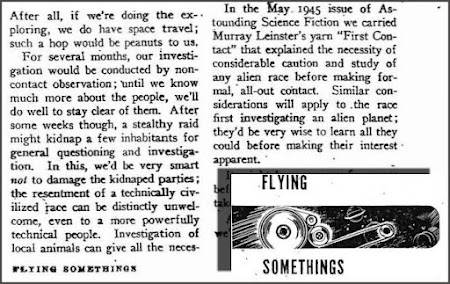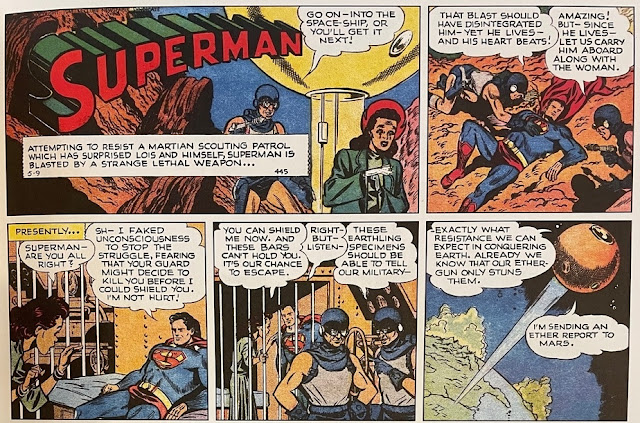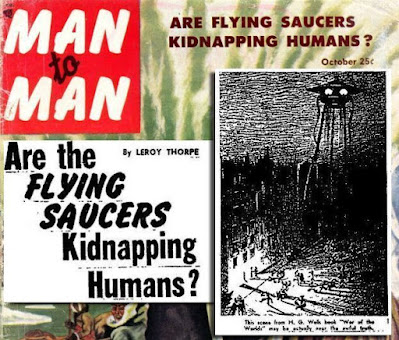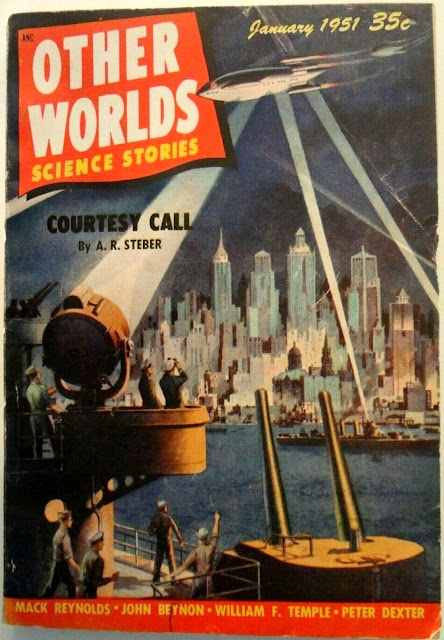
Before the Roswell incident, there was “the Battle of Los Angeles,” and both were big 1940s military-related newspaper stories later resurrected as major UFO cases. Our examination is not about primarily about what was in the California night skies in February 1942. Rather, we ask:How, when, and why did this incident become associated with UFOs?
The Battle
The basic story is that during the early days of World War II, the “battle,” started with a plane being detected by radar off the coast of California, and the city of Los Angeles being blacked out. There was a very real fear that a second attack from Japan was coming, and it caused a panic. Searchlights roamed the sky while anti-aircraft artillery shells were fired at flying phantoms. The events were covered by the Los Angeles Times, Feb. 26, 1942:
 |
"SEEKING OUT OBJECT - Scores of searchlights built a wigwam of light beams over Los Angeles early yesterday morning during the alarm. This picture was taken during blackout; shows nine beams converging on an object in sky in Culver City area. The blobs of light which show at apex of beam angles were made by anti-aircraft shells.” |
Witnesses described seeing many things; blimps, balloons, strange lights, squadrons of planes in formation, while others saw nothing besides the searchlights.
A less dramatic photo appeared in Life magazine March 9, 1942, in the article, “Japanese Carry War to California Coast.”
No Japanese aircraft were found to be involved, so in the aftermath of the battle, there was a controversy due to the uproar and damage caused by firing the artillery shells. People wanted to know: What was the Army shooting at, and if nothing, why? No one seemed to want to take responsibility for the mistake, and in that sense, maybe there was a coverup. In any case, the Martians were not suspected – yet.
Spaceships and Saucers
 |
| Spaceship in searchlights from Astounding, May 1940. |
Amazing Stories Feb. 1946 had a cover illustration reminiscent of the Battle of Los Angeles photo. Editor Ray Palmer, and AS June 1947
Carrying a cover date of June 1947, Palmer put out a special all-Shaver Mystery issue, released weeks ahead of the flying saucer sightings of Kenneth Arnold. In his editorial, Palmer presented the 1942 Los Angeles incident as sightings of spaceships, evidence in support of Shaver’s tales:“Communication between these underground races (because they have the mechanical means to do so) and peoples who travel space in space ships, and sometimes venture near a sun-planet for raiding purposes (to steal ancient machines and supplies and to procure slaves), is postulated by Mr. Shaver, and borne out by the incredible number of reports we have and have had in the past, of visiting ‘ships’ in the sky (such as the mysterious ‘air raid’ suffered by Los Angeles during the war, and which the army now reveals has never been explained, except that it was no private or military plane of our own, and none of the Japs or any foreign power, but was certainly tracked by radar, and observed by many people to ‘appear to be rocket ships’ from three to five in number).”
The flying saucers sightings began shortly afterwards. Covering the controversy, the Los Angeles Times, July 8, 1947, ran an editorial article, “Have You Reported Your Flying Disk?” It skeptically suggested that UFOs sightings might be caused by disintegrating meteorites or a quirk of reflected light, and “From then on, autosuggestion is sufficient to carry it, as was the case with the 1942 ‘Battle of Los Angeles,’ when anti-aircraft bursts caught in searchlight beams were magnified into 27 twin-engined Japanese bombers, majestically flying in formation.”
 |
Los Angeles Times, July 8, 1947 |
Into the 1950s
Ray Palmer left Amazing, but he launched a new similar magazine. Other Worlds Science Stories, January 1951 featured cover art by by James Settles for "Courtesy Call" by Roger P. Graham, writing under the house name, A. R. Steber. It was a first contact story, where a signal from space heralded the arrival of an extraterrestrial ship.
A delegation of US authorities gathered on the coastline to meet the visitors, and the narrator said:
“I got out of the car and looked over the water. Here and there broad pillars of light climbed upward into the sky, searchlights seeking for the first glimpse of the space ships. Even as I looked the first beam caught one of them. At once a dozen of them swung over to fix it and follow it in its lazy downward swoop. It seemed cigar shaped, a typical science fiction conception of a space ship with its large stern rockets, until it banked. Then its full proportions were revealed, a gigantic discus that could have perched over the financial district, resting on the spires of skyscrapers.”
Its cover illustration was evocative of the Battle of 1942, but in this instance, there were only spotlights aimed at the skies, not artillery shells.LIFE magazine May 21, 1951 featured a long article by Winthrop Sargeant that seriously discussed Science Fiction, but also discussed the trashy side, things like Bug-Eyed Monsters and the Shaver Mystery. Describing Ray Palmer’s publication of the Shaver tales, Life said:
“The deros were responsible for much of the evil in the world… [behind] virtually every mysterious or unexplained occurrence reported in the news. They were held responsible for the disappearance of Justice Crater, for the mysterious ‘air raid’ over California just after Pearl Harbor, for the reports of flying saucers.”
The 1942 shelling and the topic of saucers were mentioned together again, in the Los Angeles Times, Aug. 1, 1952, but as an argument against the reality of UFOs. Veteran columnist Bill Henry referred to "the great ‘Battle of Los Angeles’ of 1942 in which something resembling a flying saucer — it was really an errant weather balloon — touched off the gosh-durndest artillery barrage that our community has witnessed before or since."
 |
Los Angeles Times, Aug. 1, 1952 |
The Air Force files of Project Blue Book contains letters received with reports of flying saucers, both new and old, but none of them mentioned the Los Angeles events. It wasn’t part of UFO history.
The 1960s: The Battle Enters UFO Lore
Ray Palmer had tried to bring spaceships into the story, but it didn’t take. About 25 years later, the Battle was finally adopted by ufology. The 1960s saw a resurgence of public interest in flying saucers and several authors were looking at old wonders in the sky to present as UFO cases. That may have prompted the rebirth of the Los Angeles story.
The first known direct association of the 1942 incident with UFOs comes from M. A. McCartney’s letter to National Investigations Committee on Aerial Phenomena (NICAP) dated Jan. 10, 1966. McCartney had been a 23-year-old air-raid warden, and he reported seeing a brightly glowing, spherical red object over Hawthorne (southwest of L.A.) As quoted in The UFO Encyclopedia Volume 2 by Jerome Clark, 1992:
“It traveled horizontally a short distance very slowly and then made an abrupt 90-degree [turn] rising abruptly,” he said. “Again it stopped and remained motionless.”
Summarizing McCartney’s account, Clark wrote, “After a few minutes it flew away and was lost in the distance.” NICAP did not publish the letter at the time, so it didn’t play a public role in popularizing the story. However other people were on the verge of making the connection to UFOs.

“The next morning, the Los Angeles Times printed several articles on the matter and even displayed a photograph showing the unidentified flying object in the sky. The article said that the Army’s Western Defense command insisted the blackout was the result of unidentified aircraft sighted over the city."
Only a few buffs read it, but in 1967, a new 5-page article by Kenneth Larson, “First Authentic Flying Saucer Photo” appeared in Flying Saucers Pictorial - The world's largest collection of UFO Photographs!, a magazine format volume edited and published by Max Miller. It was carried in newsstands and reached a general audience. It was the first presentation of the 1942 picture as something anomalous, and Larson concluded that since what was fired at could not be shot down, “It seems obvious that these objects that flew over Los Angeles in 1942 were UFO’s.”
Flying Saucers Pictorial
More exposure came when Brad Steiger and Joan Whritenour picked up on Larson’s story in Saucer Scoop and summarized it in their 1967 book, Flying Saucers are Hostile. (No photo was included.)
John P. Bessor (originator of the 1947 hypotheses that UFOs are celestial animals), had a letter published in Fate magazine April 1967, warning against the cruelty of exorcising of ghosts, since they might be banished into space and bothered by things like satellites and UFOs. He closed with a tangential question:
“Incidentally, has anyone the full story on the torpedo-shaped objects that hovered for more than an hour over Los Angeles one night in January or February, 1942 — drawing considerable anti-aircraft fire? — J. Bessor, Pittsburgh, Pa.”
Gordon Lore and Harold Deneault of NICAP focused on pre-1947 UFO events in their 1968 book, Mysteries of the Skies: UFOs in Perspective. Chapter 6 (pages 74-87) was titled “The Battle of Los Angeles,” and their primary source was “Raymond Angier, an aircraft worker who did double duty as an air raid warden.
Angier provided extensive notes he had compiled after the sighting and told the story behind the story of February 25, 1942.” Their examination was of the reports of the “unidentified lights” and the “flares and blinking lights” described as hovering near defense plants that night. The famous searchlights photo was not discussed or reproduced. The authors concluded, “Although it cannot be proved beyond a doubt that no planes were over Los Angeles on the morning of February 25, the evidence is more in favor of unidentified flying objects.”
“The UFOs of 1942” by Paul T. Collins appeared in Exploring the Unknown, September 1968, and later reprinted in Flying Saucer Digest No. 19 in 1972. Collins included his personal testimony, over 25 years after the events, saying he: “noticed a strange pattern of movement in certain bright red spots of light in the sky over Long Beach. It was a pattern which could not possibly have been made by any man-made object, or by beams of light, either from the ground or from aircraft.”
NICAP issued a UFO calendar in 1972 of historical highlights, and for Feb. 24, it featured the “Battle of Los Angeles.”
Ralph and Judy Blum mentioned the story in their 1974 book, Beyond Earth: Man’s Contact with UFOs, chiefly from the perspective of Ralph’s childhood memories of the shelling incident.
The Rest is History
The Battle of Los Angeles gradually was cited more frequently in books and magazines as an early flying saucer case, and it slowly entered the UFO canon. Above Top Secret by Timothy Good, 1987, featured a section, “The Los Angeles Air Raid, 1942,” and the books’ illustrations included the photo.
Exposure peaked around 2010 due to the exploitation of the 1942 story and photo in the marketing of the 2011 Columbia Pictures science fiction movie, Battle: Los Angeles. The promotion of the film was aided and abetted by several ufologists, cementing the UFO connection in popular culture.
It was also around this time that it was revealed that the flying saucer ufologists were seeing in the convergence of the searchlights in the LA Times photo was man-made. In 2011, Reporter Larry Harnisch located the print used in the Times and said,
“much of what you see in this photo is painted: The beams from the searchlights are airbrushed. The supposed bursts of antiaircraft shells are blobs of paint… [the] darkened skyline, is a combination of black paint outlined with the faintest edge of airbrushing.”
 |
Los Angeles Times file photo |
Tim Printy wrote a skeptical examination of the photo and story as UFO evidence in his online magazine see SUNlite vol. 3.no. 1, “The Battle of LA UFO story.” Printy also located The Antiaircraft Journal, Volume 92, Number 3, May-June 1949, which featured “Activities of the Ninth Army AAA” by Col. John G. Murphy, CAC.
“L.A. ‘Attacked,’" was Murphy’s eyewitness testimony and explanation of the events:
“Roughly about half the witnesses were sure they saw planes in the sky. One flier vividly described 10 planes in V formation. The other half saw nothing. … Once the firing started, imagination created all kinds of targets in the sky and everyone joined in. Well after all these years, the true story can be told. One of the AA Regiments (we still had Regiments) sent up a meteorological balloon about 1:00 AM. That was the balloon that started all the shooting! When quiet had settled down on the ‘embattled’ City of the Angels, a different regiment… sent up a balloon, and hell broke loose again. (Note: Both balloons, as I remember, floated away majestically and safely.)”
"Necessity is the Mother of Invention”
Ray Palmer got there first, and he knew something about how to attract readers, and he certainly helped get the UFO business rolling. Since 1947, there has been a public appetite for new UFO cases, one that can’t be satisfied by the pace of genuine sightings. By mining historical events, enterprising ufologists can discover or manufacture “new” UFO cases for their audiences. |
| (Spurious ufologist illustration) |
Particularly rich ore can be found in the ambiguity of events clouded with confusion and contradictory witness testimony. With some selective editing, old stories can be recast into something phenomenal. . . .
For Further Reading
To go beyond our summary of the incident, see the original news coverage at the Los Angeles Times.
The Battle of Los Angeles at Saturday Night Uforia, is an excellent resource for anyone wanting to examine the events and what followed.
Another good collection of photos and information is The Battle of L.A., 1942 by Scott Harrison at Los Angeles Times.com
Thanks to Vicente-Juan Ballester Olmos, Isaac Koi, and Tim Printy for research materials and resources used in this article.























































